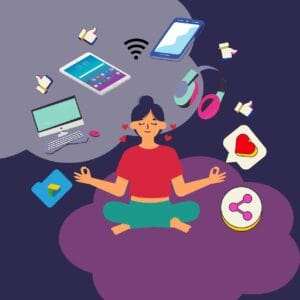Introduction
In today’s hyper-connected world, achieving a true work-life balance has become more challenging than ever. The lines between professional and personal lives blur as work emails, notifications, and social media constantly demand our attention. Without practicing digital wellness, it’s easy to fall into a cycle of burnout, reduced productivity, and strained relationships.
By understanding the principles of digital minimalism and intentional living, you can reclaim your time and energy, fostering a balanced lifestyle and meaningful relationships. This guide explores digital wellness, its challenges, and effective strategies to create a healthier relationship with technology.

Understanding Work-Life Balance in the Digital Age
Before practicing digital wellness, it’s crucial to define what work-life balance means for you. It involves:
- Setting clear boundaries between work and personal time.
- Distinguishing between entertainment and productivity to avoid unnecessary digital distractions.
- Knowing when to engage with technology and when to disconnect.
Pain Point: The Always-On Culture
With smartphones and remote work, employees feel pressured to be constantly available, leading to stress and exhaustion.
Solution: Implementing Work Boundaries
- Set work hours and communicate them to your employer, colleagues, and clients.
- Use apps that schedule “Do Not Disturb” hours to reduce notifications during personal time.
- Log out of work email and messaging apps after hours to prevent the temptation of checking in.
Assessing Your Digital Culture
Digital culture represents the habits and practices surrounding technology use in both personal and professional spaces. Assess your digital culture by asking:
- Do my coworkers and family respect digital wellness?
- Do I have a set of principles guiding my technology use?
- Am I using technology to empower myself and others, or am I contributing to digital clutter?
Pain Point: Digital Overload and Constant Distractions
Many people experience information overload, leading to decreased focus and productivity.
Solution: Practicing Digital Minimalism
- Unsubscribe from unnecessary emails and notifications.
- Remove non-essential apps that contribute to digital clutter.
- Implement “batch processing” for emails and social media, limiting their use to designated times.

The Right to Disconnect: A Global Movement
The “right to disconnect” is an emerging movement advocating for the ability to unplug from work-related communications outside office hours. Some companies have embraced this principle:
- BMW treats after-hours emails as overtime.
- Virgin enforces a company-wide “email blackout” for two hours each week to encourage deep work.
- Volkswagen limits internal email services to working hours only.
Pain Point: No Clear Separation Between Work and Personal Life
Many remote workers struggle to switch off from work, leading to increased stress levels.
Solution: Creating a Work-Free Personal Space
- Designate a specific work area at home to create a mental boundary.
- Develop a shutdown ritual, such as a walk or meditation, to transition from work to personal time.
- Advocate for company-wide digital wellness policies that respect employees’ personal time.
Communicating Changes Effectively
To successfully practice digital wellness, open conversations with family, friends, and colleagues are essential. Discuss your need to reduce screen time and improve focus with empathy and clarity.

Pain Point: Resistance from Others
Some people may not understand your need for digital boundaries and may perceive it as ignoring them.
Solution: Educate Through Personal Examples
- Share your experiences and explain how reducing screen time has improved your well-being.
- Listen to others’ experiences with technology-related stress and offer support.
- Frame digital wellness as a collective effort rather than an individual restriction.
Building Meaningful Connections in a Digital World
While digital communication connects us across distances, it can sometimes replace genuine, face-to-face interactions. Understanding social capital can help you prioritize meaningful connections:
- Bonding Social Capital: Deep relationships with close friends and family.
- Bridging Social Capital: Broader, less intimate connections used for networking and professional growth.
Pain Point: Digital Isolation Despite Constant Connectivity
Spending excessive time online can create a false sense of connection while reducing real-life social interactions.
Solution: Prioritizing Quality Over Quantity
- Schedule in-person meetings or phone calls instead of relying on text-based communication.
- Reduce passive scrolling and instead engage meaningfully in digital conversations.
- Join interest-based communities that encourage real-world interactions.

Addressing Digital Interference
Certain digital habits can interfere with relationships and productivity. Identifying and eliminating them is a key part of practicing digital wellness.
1. Phubbing (Phone Snubbing)
Pain Point: Constant phone use during conversations makes others feel ignored.
Solution: Implement a “no phone at the dinner table” rule and practice active listening.
2. Zoom Fatigue
Pain Point: Excessive virtual meetings cause mental exhaustion and reduce engagement.
Solution: Opt for audio calls when video isn’t necessary and schedule screen-free breaks.
3. Always-On Culture
Pain Point: Feeling the need to respond instantly to messages creates stress.
Solution: Set communication expectations with coworkers and establish response time guidelines.
4. Mere Presence Effect
Pain Point: The mere visibility of a smartphone can distract from deep conversations.
Solution: Keep your phone out of sight during important discussions and social gatherings.
Practicing Digital Wellness: A Step-by-Step Plan
- Conduct a Digital Detox: Take a 24-hour break from screens to reset your habits.
- Create Tech-Free Zones: Keep bedrooms and dining areas free from digital devices.
- Schedule Screen Time: Allocate specific times for social media, emails, and entertainment.
- Monitor Screen Usage: Use apps like Screen Time (iOS) or Digital Wellbeing (Android) to track usage.
- Prioritize Mindfulness: Engage in offline hobbies, such as reading, exercise, or meditation.
- Establish Digital Etiquette: Encourage colleagues and family members to respect digital boundaries.
Practicing digital wellness is essential in today’s fast-paced, technology-driven world. By setting clear boundaries, assessing digital habits, and fostering meaningful connections, you can reduce stress, enhance productivity, and improve overall well-being.
The journey toward digital balance starts with small, intentional changes. Implementing these strategies will empower you to reclaim control over your time, attention, and relationships. Digital wellness isn’t about eliminating technology—it’s about using it mindfully to support a healthier, more fulfilling life.
By following these steps, you’ll not only improve your work-life balance but also encourage those around you to embrace digital wellness. Start today, and experience the benefits of a more intentional and connected life.
The Importance of Practicing Digital Wellness
Defining Work-Life Balance
To practice digital wellness, you must first define what work-life balance means for you. It includes:
- Setting clear boundaries between work and personal time.
- Distinguishing between entertainment and productivity.
- Knowing when to engage with technology and when to step away.
Assessing Your Digital Culture
Digital culture influences your habits and interactions with technology. To assess your current digital wellness, ask yourself:
- Do I use technology to empower myself and others?
- Am I creating valuable digital content, or am I merely consuming it?
- Does my technology use align with my personal and professional goals?
By reflecting on these questions, you can begin to make positive changes in your digital wellness routine.
Strategies for Enhancing Work-Life Balance
1. Intentional Technology Usage
Being mindful of how and why you use technology is key to practicing digital wellness. Implement the following strategies:
- Define goals for each platform. Use LinkedIn for professional networking and messaging apps for personal connections.
- Limit screen time by scheduling tech-free hours or designated digital detox days.
- Implement app restrictions to minimize social media overuse.
Example:
Sarah, a freelancer, realized she was losing hours scrolling through social media. She set app timers and now spends only 30 minutes daily on non-work-related platforms, significantly improving her focus.
2. Direct Communication
Favor direct, meaningful conversations over passive interactions. Instead of relying on likes or comments to maintain relationships, opt for genuine, personal outreach.
Practical Tips:
- Call a friend instead of sending a text.
- Schedule in-person or video catch-ups rather than engaging in shallow digital conversations.
- Use email and messaging for productivity, not for unnecessary distractions.
Example:
Mark noticed his friendships were weakening due to passive online interactions. He started making weekly phone calls, which strengthened his relationships and decreased his reliance on social media.
3. Prioritizing Strong Ties
Building and maintaining strong personal connections is essential for emotional well-being and practicing digital wellness.
- Invest in quality time with close friends and family.
- Limit shallow online interactions in favor of deeper, more meaningful relationships.
- Join community groups or engage in shared activities offline.
Example:
Instead of aimlessly browsing Facebook, Emily set up a monthly in-person gathering with friends, fostering deeper connections and reducing screen time.
4. Embracing Presence
To practice digital wellness, focus on being fully present in social and work interactions:
- Avoid multitasking when spending time with loved ones.
- Designate digital-free zones in your home.
- Set work hours and turn off notifications outside of these times.
Example:
John established a “no-phone dinner” rule at home, which led to more meaningful conversations with his family and reduced their collective screen time.
Overcoming Common Digital Wellness Challenges
Challenge: Digital Overload & Burnout
Solution: Implement mindfulness practices such as meditation or journaling. Schedule downtime to disconnect and recharge.
Challenge: Difficulty Setting Boundaries
Solution: Use tools like “Do Not Disturb” mode and automated email replies to indicate when you are unavailable.
Challenge: Fear of Missing Out (FOMO)
Solution: Shift focus from digital consumption to real-world experiences. Engage in hobbies and offline activities.
Coaching Through Digital Awareness
As you deepen your understanding of practicing digital wellness, you can guide others by:
- Leading by example.
- Recognizing digital stressors in yourself and others.
- Encouraging open discussions about digital well-being.
Example:
Lisa, a team leader, noticed her employees were overwhelmed by after-hours emails. She implemented a “no email after 6 PM” policy, resulting in improved morale and productivity.
Ending on a Hopeful Note
Digital wellness is not about eliminating technology but using it intentionally.
- Set realistic goals and track progress.
- Offer support and hold yourself accountable.
- Enjoy the benefits of a balanced digital lifestyle.
By practicing digital wellness, you create a healthier relationship with technology, leading to better mental well-being, stronger relationships, and increased productivity.
FAQs Work Life Balance
What is digital minimalism?
Digital minimalism is a philosophy advocating intentional technology use, focusing on tools that add value to your life while minimizing distractions.
How can I start practicing digital wellness?
Begin by assessing your digital habits, setting boundaries, and communicating your intentions with others. Gradually implement changes and lead by example.
How does technology impact relationships?
Excessive or mismanaged technology use can lead to disconnection in personal relationships, replacing meaningful interactions with superficial connections.
What is the right to disconnect?
The right to disconnect is a principle promoting boundaries around work-related communication outside office hours, ensuring personal time is respected.
How can I improve work life balance in a digital age?
Prioritize direct communication, set clear boundaries, embrace presence, and invest in meaningful relationships both online and offline.


